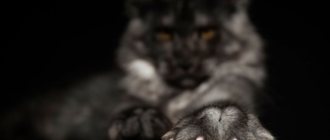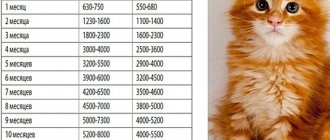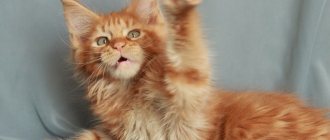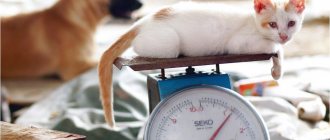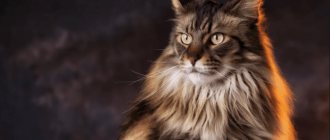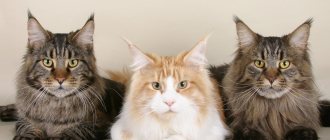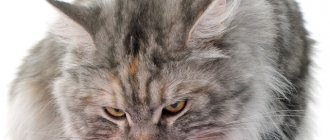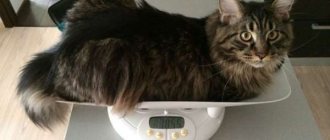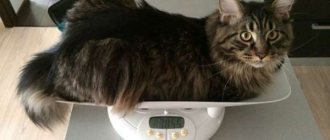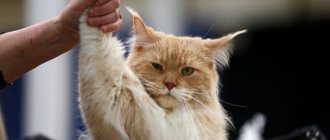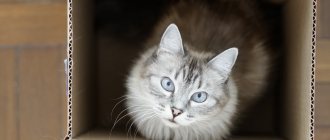Future owners and just people who have seen a Maine Coon for the first time are interested in what height and weight this cat reaches. The elongated body, large head, paws and tail, developed muscles and long hair give the impression that this is a very massive animal.
There are stories that say Maine coon cats gain up to 15-20 kg. And many owners try to fatten their pet to such parameters. You should approach this with caution. It is useful to know what sizes are normal for Maine Coons, so as not to harm your pet.
Maine Coon Size Standards
Upon reaching 15 months, the growth of the coon is completed and until the age of three they gain only muscle mass.
The weight of a male at one and a half years old can reach 8-10 kilograms. Girls are more modest in size - about 8 kilograms. Before reaching the age of one year, there are some females that can be similar in size to the males. The weight of a coon may change after spaying and neutering (for cats). This is caused by hormonal imbalance. For such cats, you need to select special food and monitor physical activity. You can often find information that coons have enormous height and weight exceeding 25 kg. This is a very persistent myth that is simply a myth and a fallacy. If a Maine Coon cat exceeds 12 kg, this may indicate problems with the health of the animal.
There are official records for the size of coons that were exhibited at exhibitions and competitions. The largest cat had a body weight of 15 kilograms. The physique of this breed is muscular and has a large head. They have characteristic tassels on their ears and a long fluffy tail.
They are friendly but not tame
It is almost impossible to tame a Maine Coon completely; they have a wayward, daring character that they retain for the rest of their lives.
Probably everyone has seen photos in which people hold Maine Coons and straighten them to their full width, and you can see how huge they are.
They are really larger than ordinary cats, it’s all about special selection. It’s not for nothing that this is considered a royal breed of cats, since they are from those same Imperial times. If you manage to tame such a “miracle”, then you should definitely think about a circus career! He is the owner of the house and not you, and it is better for you not to argue with this, otherwise there will be a lot of scratches, and it is better not to lead to bites
What is the weight of an adult cat and Maine Coon cat?
The size and weight of a kun depends on many factors. The state of an adult cat is established at birth. The size of the animal is affected by:
- Genetics. If the kitten's parents were large and in good health, there is a high probability that the kittens will also be of impressive size.
- Floor. Males are larger and taller than females. Males also grow faster than their female counterparts.
- The use of hormonal drugs in a cat during certain periods.
- Conditions in which kittens grow up.
- Stress factor. If an animal is constantly exposed to stress, the endocrine system of the animal suffers first, which negatively affects further growth.
- Proper nutrition. It must be balanced. By following proper nutrition, healthy and strong coons will grow up with the correct size and weight.
Typically, a cat stops growing and gaining weight at the age of three. During this period it should reach its maximum size. For a male, the weight can range from 9-12 kg, castrated individuals can weigh 13-16 kg. All cats should be between 7-10 kg. The height at the withers can reach 25-40 cm. The length of the body from the nose to the tip of the tail can reach 100 cm, that is, 1 m. The maximum length established by the kunas is 1.23 m.
Maine Coon cat.Thoroughbred animals with a good pedigree will look larger and more massive than their counterparts. This is dictated by a special genetic exterior.
Unique voice
From birth, all Maine Coons have a uniquely gentle voice, which becomes louder over the years, but still not louder than the voice of ordinary cats. It’s strange that no one has thought about recording an album with them yet. After all, it is only because of the bird's voice that it is worth having at least one of them. If you have never had a parrot or any other bird, then you can start with a Maine Coon; by ear you won’t even notice the difference. Don't believe me? Be sure to check it out for yourself. It’s easy to describe this voice, it is similar to the voice of a magpie, only in terms of energy it is many times stronger and brighter, especially when Maine-kun asks for food! Scientists have not yet agreed on why Maine Coons have such a voice; many complain about special vocal cords, but it is worth noting that if an ordinary cat’s voice becomes different over the years, then in a Maine Coon it simply becomes louder!
Maine Coon weight by month
To understand what health condition a pet has, veterinarians have developed a special table that can be used to check its body weight.
How much do Maine Coons weigh: table by month.
Coon kittens grow very quickly and gain weight rapidly. When they reach 4 months, they can be the size of a normal adult cat. The pace of development slows down over the years and stops altogether after three years.
Birth weight
Kittens of this breed are larger in size compared to other cats. A newborn kitten weighs 120-170 grams, but for example, a Persian kitten weighs only 80-100 grams. If we take into account the average size, the usual weight of a coon kitten reaches 140 grams. In many ways, this figure may vary depending on the size of the entire litter. If there were five kittens, the weight could be within 130 grams, if there was only one kitten - 160 grams. The more kittens in the litter, the less their body weight will be.
How to distinguish a purebred kitten when buying
Distinctive features of the Maine Coon breed that will help you avoid making mistakes in choosing a pet.
Characteristic signs
- At 5 weeks, the size of a Maine Coon corresponds to the parameters of a regular six-month-old kitten; at 4-5 months they reach the size of an adult cat.
- The eyes are almond-shaped and slanted; other cats have round eyes.
- Large ears are located perpendicular to the head, there is no forward tilt. Wide at the base, they gradually taper upward, and tassels are observed at the tips - an exceptional external sign that most often appears by 3 months, although sometimes it can already be present at birth.
- The length of the head is greater than the width, so it is slightly elongated. The cheekbones protrude significantly, which is not the case in ordinary domestic kittens. The features are clear. A “box” is formed in the area of the mustache and chin, which makes the muzzle square.
- Large paws with fur between the claws.
- The tail is 2 times longer than that of ordinary kittens.
- Thick coat of medium length.
- The body is strong, the bones are massive, and the chest is wide.
Regular kitten and Maine Coon
There are some differences between a Maine Coon and a regular kitten. Breeders monitor intraspecific crossbreeding so as not to lose the characteristics of a purebred cat. Pets are born weighing 100-150 g, and by 3 months they grow to 2-2.5 kg. Strong and active, they develop quickly. Eyes open early.
The coat is fluffy and thick from the moment it is born. Powerful chest. The head is extended upward, as the length is greater than the width. The tail is long and bushy, and the paws are large with hair between the claws. They begin to eat regular food at an early age.
The guarantee of an animal's thoroughbredness is its pedigree.
A newborn ordinary kitten weighs 80 - 100 g. By 3 months the weight is only 1-1.5 kg. Small and blind, they rest a lot. Less active and late trying to get on their paws.
They feed on mother's milk for a long time and only with the appearance of their first teeth do they switch to food.
It is worth purchasing a pet from 3 months, at this moment the signs of a purebred pet will be clearly expressed. And you certainly can’t go wrong on how to distinguish a Maine Coon from an ordinary kitten.
Differences from mestizo
Crossbreeds still occur, although interbreed matings are prohibited. It is difficult to distinguish a mestizo from a real Maine Coon, since the former have the external features of purebred pets. It is better to consult a specialist who will help you determine whether the cat in front of you is a purebred or a fake.
A Maine Coon is considered purebred if ancestors in 4 generations are mentioned in the pedigree. Outbred and mixed animals only have a veterinary passport, which the owners do at their own request. Pedigree records are not issued.
A distinctive feature of a purebred pet is its size. The weight of an adult Maine Coon is at least 6-7 kg. Also, mixed-breed kittens look much smaller than their purebred counterparts.
You should also pay attention to the cost of the pet: mixed breeds are sold at a lower price than purebred ones.
Siberian kittens and Maine Coons
When comparing kittens of two species, you can see their pronounced similarity to their wild forest counterparts: Maine coons resemble lynxes in their habits, and Siberian kittens are remotely similar to manul cats.
Maine Coons have an elongated body with a long neck. The muzzle, as if chiseled, with sharp transitions, strongly pronounced cheekbones, with a clearly defined chin located in line with the nose, is one of the features of these cats. The ears point upward and have tassels at the tips.
In addition, this breed has large slanted eyes, which can only be found in purebred representatives. They have different colors. Only varieties of chocolate, fawn, cinnamon and acromelanic combinations are considered not to have received recognition.
Siberian kittens are more densely built, they have a short and powerful neck. The lines of the muzzle are smooth, the chin is rounded, the cheekbones are set low. Deeper and wider chest. The ears are round, slightly tilted forward.
The roundness of the back is also observed. Siberians have shorter paws, which is why the Maine Coon is much taller.
Why does a Maine Coon kitten not gain weight?
As soon as the owner notices a discrepancy with the body weight table, it is worth seeking help from veterinarians. Insufficient recruitment can be caused by a number of reasons:
- lack of vitamins;
- non-compliance with energy balance;
- the kitten is stressed;
- genetic or acquired diseases of the kitten.
If a cat gives birth to small newborn kittens, they may develop more slowly and take longer to reach the required weight and body size. Larger ones develop much faster than their smaller peers. Small size is often due to genetics.
Sometimes there are situations when just small kittens are born. This can be called a genetic failure; it cannot be corrected. You should not give your kitten any supplements that affect growth on your own. All drugs should be prescribed only by a veterinarian and if there are compelling reasons for their use.
Why can a Maine Coon lose weight?
Body weight standards affect the portion of food that domestic coons should receive. If suddenly your pet begins to lose body weight, this may indicate the presence of health problems. It is important to take action in time and contact a veterinarian. Typically, there are many reasons for weight loss:
- change in diet or diet;
- poor nutrition;
- use of low-quality products;
- worms or other parasites;
- hereditary factors;
- hormonal imbalances;
- poor animal hygiene;
- serious illnesses.
At the first signs of weight loss, it is worth paying attention to the animal’s diet. Perhaps it is not receiving enough necessary nutrients. If there have been no changes in the diet, the cause may be the stressful state of the coon. In any case, weight loss is most often due to health problems. In this case, only specialists can help and immediately prescribe adequate treatment.
Material on the topic: all about the character and habits of Maine Coons.
Maine Coon kitten.
What to do if your pet is obese
If your pet is obese, it is first important to determine the cause. Some foods are contraindicated for kittens and adult animals, such as chicken and fish bones, which can damage the esophagus. You should not give your pet raw meat, especially pork. Meat products without heat treatment can become a carrier of infection and worms. Starchy vegetables, such as potatoes, can cause diarrhea, so you shouldn't give them to your pet. Legumes have a negative impact on the digestive tract. Smoked meats, pickles, spicy and fatty foods are harmful to cats. After identifying the cause, it is necessary to develop a diet, but the pet should not be very hungry. It is better to seek a decision from a specialist who will accurately describe the entire menu, taking into account the necessary vitamins and microelements for the pet.
A healthy, large pet is the result of good care and love from the owner. It is important to pay due attention to the cat, then it will delight you for many years.
Factors influencing growth
Factors that influence the growth and development of the Maine Coon can be divided into two types - internal and external. Internal ones include:
- The growth rate of a kitten depends on the breed and its purebred. The higher your birth weight, the more you will gain weight in the future.
- Gender of the kitten. Boys grow faster and gain weight.
- Genetic predisposition. With a high degree of probability, parents of large sizes will have kittens of corresponding sizes.
- The combination of mom and dad's genotypes creates the kitten's own genotype. This is a unique organism that can have its own individuality.
- Hormones. The use of medications can affect the animal's body weight.
There are also external factors that have a significant impact on weight gain and growth of the Maine Coon. These factors include the hygiene of the animal and the conditions in which it lives. The attitude of the mother cat towards him greatly influences the growth of a kitten; sometimes a cat may deprive one of its cubs of attention and care. A newborn kitten should gain 10 grams in weight. in a day.
Kitten development
The weight of Maine Coon cats depends not only on the genetic reserve, but also on how responsibly the owner of the animal treats nutrition. Height and weight vary at different stages of a kitten's development, but should always be consistent with each other.
Cats are immediately born large, and the greater the weight of the newborn, the larger the adult cat grows. Surely, you are concerned about the answer to what age Maine Coons grow. Fluffy cats actively increase in size until about a year old, then such a sharp pace decreases, but development continues until 3-4 years.
The growth stages of cats can be divided into 4 periods:
- The neonatal period of life lasts 4 days.
- In the first month it is a sucker.
- Then transitional, when the cub tries adult food. About three weeks pass, while the babies, adapting to new food, reduce their indicators of physical development.
- And after the post-suction period, at this time the kittens finally switch to independent feeding.
The structural features of the body, large muzzle and long hair of furry giants make them seem much more massive than they actually are.
Record holders
The largest Maine Coon in history had a body length of 123 cm. The tail was 41.5 cm long. This cat had a gray-smoky color, and the record itself was recorded on August 28, 2010. His name was Stewie, he lived in the USA, in the state of Nevada. Another record holder lived in Australia, his name was Omar. He weighed 14 kg. It had a length of 120 cm.
Maine Coon record holder.
One of the most sensational records concerning this breed lived in Australia and had similar dimensions.
The largest cat by weight lived in the USA. He reached a weight of 16.5 kg, and did not have any health problems that could cause such a body weight.
No artificial records
In order to achieve records, many owners begin to overfeed the cat or even introduce special hormonal supplements to quickly gain height and weight, thereby harming its health. Large weight impairs the functioning of the heart, liver, digestive tract, and also leads to metabolic disorders. This way the animal can die much faster. All this led to the fact that many international exhibitions and competitions canceled awards in this category.
Origin story
People have always loved to invent legends about various natural phenomena and stories that happened in various cities around the world. The Maine Coon is also not without amazing stories about him. There is so much fantasy, humor, and sometimes even absurdity in them.
An amazing romantic legend tells how this cat breed was created. The distant ancestors of the modern Maine Coon were cats that lived in the chambers of Marie Antoinette. When the French Revolution began, the queen decided to flee to America. Taking with her the most valuable things, including cats, she solemnly handed them over to the care of Captain Samuel Clue. They say that the queen had tender feelings for him. Marie Antoinette was soon caught and executed. But the captain managed to complete his assignment. He went to his native land - the city of Wiscasset, Maine. Having released the cats into the wild, they immediately made friends with the locals and soon gave birth to a new generation, which it was decided to call Maine Coon.
The second mysterious legend is the story of Captain Kuhn, who loved to wander the shores of New England. He loved cats, so he had a Persian cat and an Angora cat on board. At every port he visited, he released his pets for a walk. They were in a hurry to make friends with local cats. So Maine Coon kittens appeared everywhere he went.
The third fantasy story tells a completely different version of the origin. The first Americans who managed to tame Maine Coons believed that they were the result of crossing an ordinary cat with a raccoon. This is evidenced by the characteristic color, fluffy tail and the presence of tassels on the ears.
It's nice to know the legends, but in reality it was all pretty banal. This is one of the oldest breeds that lives in North America. A cat with a powerful physique appeared in the homes of the first settlers around the middle of the last century. The state of May has harsh winter conditions. Short-haired cats would be unlikely to survive, but not Maine Coons. They have thick, long hair and a warm undercoat. The presence of fluff on the paws prevents them from freezing when they run in the snow. This is a real "child" of the state of May. Here's the real origin story.
Owners of farms and large estates were in a hurry to get the breed, as they are considered excellent hunters. Maine Coons served their owners, successfully catching and destroying mice and rats. Very soon they appeared before the whole world in a completely new role when the first Maine Coon appeared at a cat show and won first place.
Useful tips and tricks
The most important task for the owner of a Maine Coon kitten is to create the right diet for him, which will ensure the normal growth and development of the animal. For coons, natural food is preferable as it is most suitable for them. Veterinarians consider poultry, rabbit, and beef to be the most appropriate. Milk can be given to small kittens; it is not suitable for adults.
Now a number of manufacturers offer specialized food for their owners. They are produced keeping in mind the body weight and size of this cat breed. Such food can be combined with natural food. Veterinarians do not have a consensus on what type of feeding should be chosen. Each owner determines this independently for his pet.
Diseases
Since the breed was formed in wild conditions, modern representatives have inherited physical strength, excellent endurance and good health from their Aboriginal ancestors. However, among them there are individuals with one or another pathology - both congenital and acquired.
Serious pathologies characteristic of Maine Coons include the following diagnoses:
- Hip dysplasia. This is explained by its underdevelopment. Accompanied by pain, instability, and immobility of the animal.
- Hypertrophic cardiomyopathy. Is a genetic defect. It is expressed in disruption of the functioning of the heart muscle. The disease has no visible signs and can be fatal.
- Spinal muscular atrophy. It has a genetic nature. Accompanied by complete muscle atrophy, shortens life expectancy.
Less dangerous disorders that are common to representatives of all breeds include:
- digestive disorders;
- formation of stones in the kidneys and urinary tract;
- skin diseases;
- dental diseases;
- parasitic infections.
